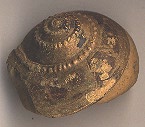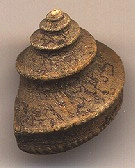| The most common
gastropod that we see today, and the one most easily recognized, is the
snail. Many a gardener knows what a snail looks like, and views it
as a nemesis, since all land-dwelling gastropods are herbivores feeding
on plant material. To the gardener, the snail is an unwanted
guest, as it likes to dine on the gardenerís garden too! Likewise
many marine gastropods are also herbivores, although some are carnivores,
preying on echinoids, crustaceans, and other molluscs such as bivalves.
To learn more about bivalves and echinoids, just click on the appropriate
icons below. |
 |
 |
| Carnivorous
gastropods appear to have first evolved during the Mesozoic era.
The first gastropods were exclusively marine, such as the Aldanella, Helcionella
and Scenella which are found in rocks of the early Cambrian period.
Quite commonly fossil gastropods from the rocks of the early Paleozoic
era are too poorly preserved for accurate identification. One of
the earliest known terrestrial, meaning land-dwelling, gastropods is Maturipupa.
It is found in the Coal Measures of the Carboniferous period in Europe.
Fossil gastropods are less common during the Paleozoic era than bivalves. |

 |

 |
Gastropods are
a large and successful group of molluscs. They have a worldwide distribution
and an estimated 105,000 living species. There are around 20,000
fossil forms. First appearing early in the Cambrian period, some
570 million years ago, they have evolved to exploit a wide variety of marine,
freshwater and land habitats. Some modern marine species live at
depths of more than 5,300 meters (17,400 feet), and on land both terrestrial
and fresh-water gastropods have been found at elevations of up to 5,480
meters (18,000 feet). Gastropods are the only molluscs to have adapted
to life on land. Other molluscs include bivalves and the cephalopods
- ammonites, belemnites, nautiloids and goniatites. Gastropod fossils
may sometimes be confused with ammonites or other shelled cephalopods.
An example of this is Bellerophon from the limestones of the Carboniferous
period in Europe which may be mistaken for a cephalopod. The shells
of ammonites may be superficially similar in appearance to those of flattened
gastropods. Ammonites however, and other cephalopods such as nautiloids
and goniatites, are distinguished by a number of features including an
internally chambered shell. To learn more about cephalopods, click
on the icon below.

|
| Gastropods have
a continuous hollow shell. As you can see in the cross-section below,
though it might appear that the interior of the shell has subdivisions,
the interior shell does not have any. This is one of the major characteristics
which differentiates the Gastropods from the Cephalopods, as with the Cephalopods,
their shells have divided chambers. The gastropod shell shows a great
deal of variation in shape, but is usually coiled in a right-handed helical
spiral. The surface of the shell may display growth lines, and can be either
smooth or ornamented with crests, ribs, ridges and spines. |

|
The term given
to each 360 degree turn of the gastropod shell is the whorl. The
remaining turns of the shell are collectively
called the spire of the shell. The last whorl, which is the largest in
size, is called the body whorl. The opening of the body whorl from
which the creature emerges is called the aperture of the shell. The
largest fossil gastropod is Campanile giganteum, which also measures over
50 centimeters, and is often found in the rocks of the Eocene period in
the Paris basin in France.
In rocks of the Mesozoic era gastropods are
slightly more common as fossils, their shells often are well preserved.
Their fossils occur in beds which were deposited in both freshwater and
marine environments. Rocks of the Cenozoic era yield very large numbers
of gastropod fossils, many of these fossils being closely related to modern
living forms. The diversity of the gastropods increased markedly
at the beginning of this era, along with that of the bivalves.
Certain trail-like markings preserved in ancient
sedimentary rocks are thought to have been made by gastropods crawling
over the soft mud and sand. Although these trails are of debatable origin,
some of them do resemble the trails made by living gastropods today.
Such fossils are called trace fossils, and to learn more about trace fossils,
just click on the image below.

|
To see what
gastropod fossils we have found, just click on the icon below.

|



